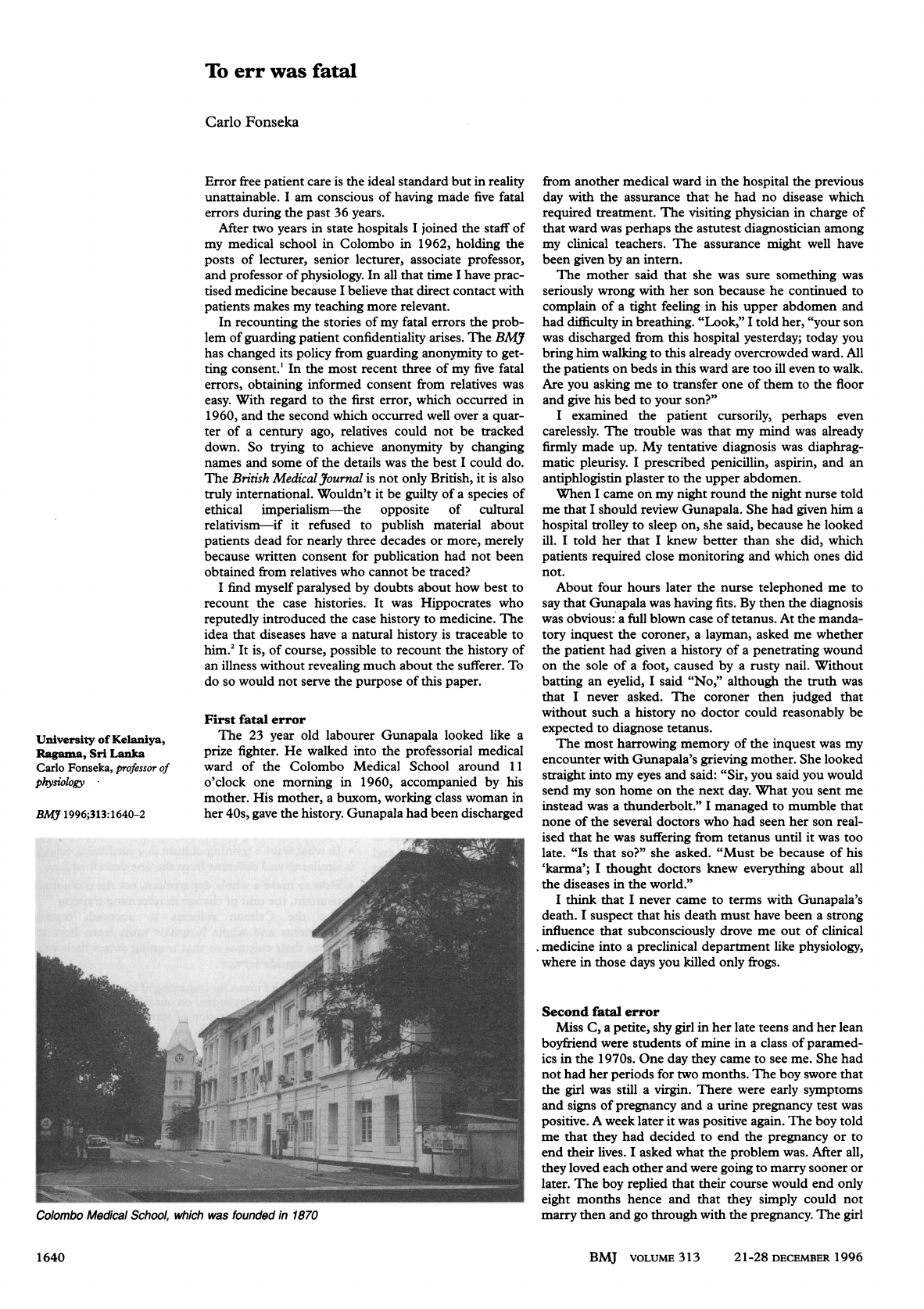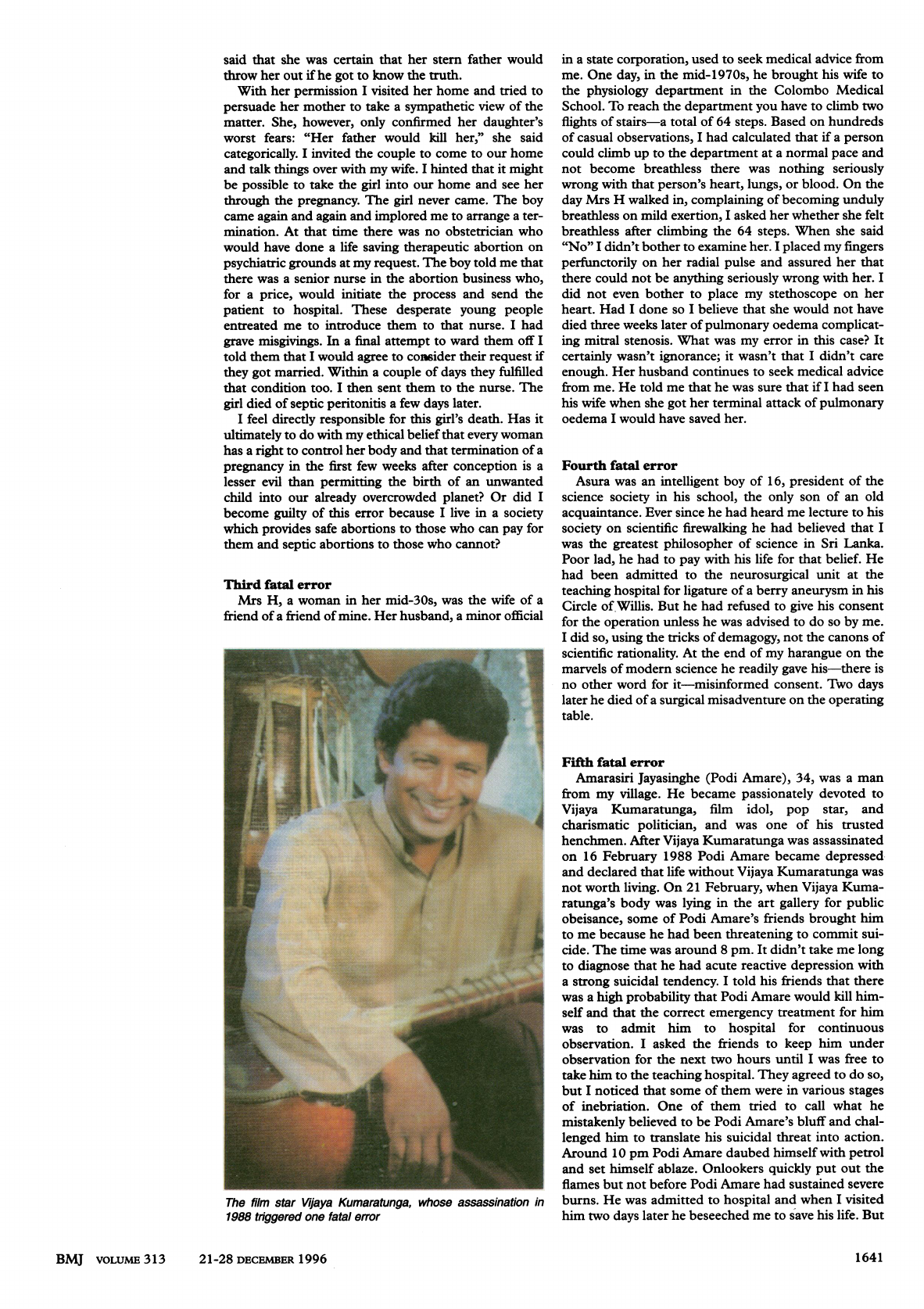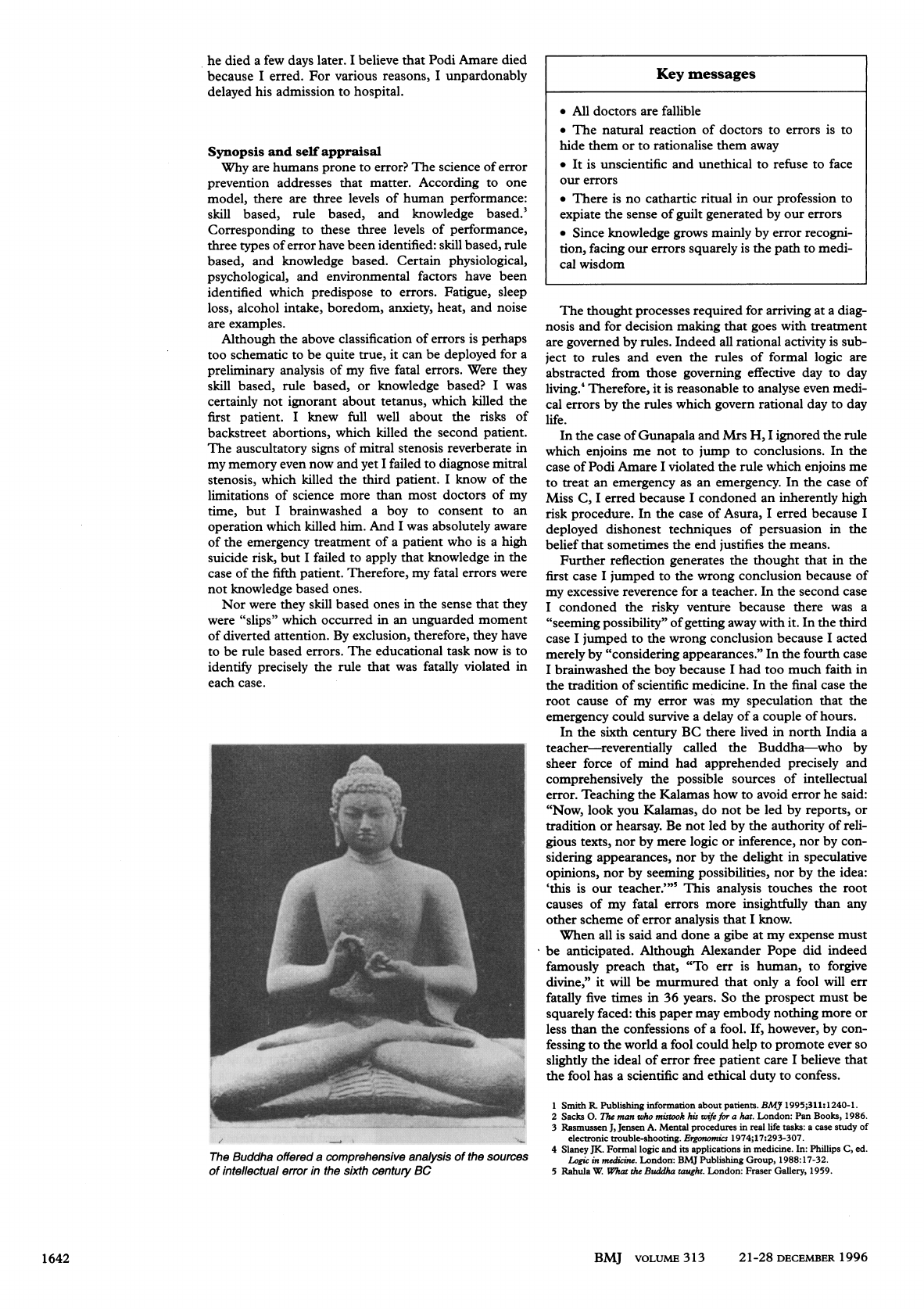
To
err
was
fatal
Carlo
Fonseka
Error
free
patient
care
is
the
ideal
standard
but
in
reality
unattainable.
I
am
conscious
of
having
made
five
fatal
errors
during
the
past
36
years.
After
two
years
in
state
hospitals
I
joined
the
staff
of
my
medical
school
in
Colombo
in
1962,
holding
the
posts
of
lecturer,
senior
lecturer,
associate
professor,
and
professor
of
physiology.
In
all
that
time
I
have
prac-
tised
medicine
because
I
believe
that
direct
contact
with
patients
makes
my
teaching
more
relevant.
In
recounting
the
stories
of
my
fatal
errors
the
prob-
lem
of
guarding
patient
confidentiality
arises.
The
BMJ
has
changed
its
policy
from
guarding
anonymity
to
get-
ting
consent.'
In
the
most
recent
three
of
my
five
fatal
errors,
obtaining
informed
consent
from
relatives
was
easy.
With
regard
to
the
first
error,
which
occurred
in
1960,
and
the
second
which
occurred
well
over
a
quar-
ter
of
a
century
ago,
relatives
could
not
be
tracked
down.
So
trying
to
achieve
anonymity
by
changing
names
and
some
of
the
details
was
the
best
I
could
do.
The
British
Medical
Journal
is
not
only
British,
it
is
also
truly
international.
Wouldn't
it
be
guilty
of
a
species
of
ethical
imperialism-the
opposite
of
cultural
relativism-if
it
refused
to
publish
material
about
patients
dead
for
nearly
three
decades
or
more,
merely
because
written
consent
for
publication
had
not
been
obtained
from
relatives
who
cannot
be
traced?
I
find
myself
paralysed
by
doubts
about
how
best
to
recount
the
case
histories.
It
was
Hippocrates
who
reputedly
introduced
the
case
history
to
medicine.
The
idea
that
diseases
have
a
natural
history
is
traceable
to
him.2
It
is,
of
course,
possible
to
recount
the
history
of
an
illness
without
revealing
much
about
the
sufferer.
To
do
so
would
not
serve
the
purpose
of
this
paper.
University
of
Kelaniya,
Ragama,
Sri
Lanka
Carlo
Fonseka,
professor
of
physiology
BM3'
1996;313:1640-2
First
fatal
error
The
23
year
old
labourer
Gunapala
looked
like
a
prize
fighter.
He
walked
into
the
professorial
medical
ward
of
the
Colombo
Medical
School
around
11
o'clock
one
morning
in
1960,
accompanied
by
his
mother.
His
mother,
a
buxom,
working
class
woman
in
her
40s,
gave
the
history.
Gunapala
had
been
discharged
from
another
medical
ward
in
the
hospital
the
previous
day
with
the
assurance
that
he
had
no
disease
which
required
treatment.
The
visiting
physician
in
charge
of
that
ward
was
perhaps
the
astutest
diagnostician
among
my
clinical
teachers.
The
assurance
might
well
have
been
given
by
an
intern.
The
mother
said that
she
was
sure
something
was
seriously
wrong
with
her
son
because
he
continued
to
complain
of
a
tight
feeling
in
his
upper
abdomen
and
had
difficulty
in
breathing.
"Look,"
I
told
her,
"your
son
was
discharged
from
this
hospital
yesterday;
today
you
bring
him
walking
to
this
already
overcrowded
ward.
All
the
patients
on
beds
in
this
ward
are
too
ill
even
to
walk.
Are
you
asking
me
to
transfer
one
of
them
to
the
floor
and
give
his
bed
to
your
son?"
I
examined
the
patient
cursorily,
perhaps
even
carelessly.
The
trouble
was
that
my
mind
was
already
firmly
made
up.
My
tentative
diagnosis
was
diaphrag-
matic
pleurisy.
I
prescribed
penicillin,
aspirin,
and
an
antiphlogistin
plaster
to
the
upper
abdomen.
When
I
came
on
my
night
round
the
night
nurse
told
me
that
I
should
review
Gunapala.
She
had
given
him
a
hospital
trolley
to
sleep
on,
she
said,
because
he
looked
ill.
I
told
her
that
I
knew
better
than
she
did,
which
patients
required
close
monitoring
and
which
ones
did
not.
About
four
hours
later
the
nurse
telephoned
me
to
say
that
Gunapala
was
having
fits.
By
then
the
diagnosis
was
obvious:
a
full
blown
case
of
tetanus.
At
the
manda-
tory
inquest
the
coroner,
a
layman,
asked
me
whether
the
patient
had
given
a
history
of
a
penetrating
wound
on
the
sole
of
a
foot,
caused
by
a
rusty
nail.
Without
batting
an
eyelid,
I
said
"No,"
although
the
truth
was
that
I
never
asked.
The
coroner
then
judged
that
without
such
a
history
no
doctor
could
reasonably
be
expected
to
diagnose
tetanus.
The
most
harrowing
memory
of
the
inquest
was
my
encounter
with
Gunapala's
grieving
mother.
She
looked
straight
into
my
eyes
and
said:
"Sir,
you
said
you
would
send
my
son
home
on
the
next
day.
What
you
sent
me
instead
was
a
thunderbolt."
I
managed
to
mumble
that
none
of
the
several
doctors
who
had
seen
her
son
real-
ised that
he
was
suffering
from
tetanus
until
it
was
too
late.
"Is
that
so?"
she
asked.
"Must
be
because
of
his
'karma';
I
thought
doctors
knew
everything
about
all
the
diseases
in
the
world."
I
think
that
I
never
came
to
terms
with
Gunapala's
death.
I
suspect
that
his
death
must
have
been
a
strong
influence
that
subconsciously
drove
me
out
of
clinical
medicine
into
a
preclinical
department
like
physiology,
where
in
those
days
you
killed
only
frogs.
Second
fatal
error
Miss
C,
a
petite,
shy
girl
in
her
late
teens
and
her
lean
boyfriend
were
students
of
mine
in
a
class
of
paramed-
ics
in
the
1970s.
One
day
they
came
to
see
me.
She
had
not
had
her
periods
for
two
months.
The
boy
swore
that
the
girl
was
still
a
virgin.
There
were
early
symptoms
and
signs
of
pregnancy
and
a
urine
pregnancy
test
was
positive.
A
week
later
it
was
positive
again.
The
boy
told
me
that
they
had
decided
to
end
the
pregnancy
or
to
end
their
lives.
I
asked
what
the
problem
was.
After
all,
they
loved
each
other
and
were
going
to
marry
sooner
or
later.
The
boy
replied
that
their
course
would
end
only
eight
months
hence
and
that
they
simply
could
not
marry
then
and
go
through
with
the
pregnancy.
The
girl
BMJ
VOLUME
313
21-28
DECEMBER
1996
Colombo
Medical
School,
which
was
founded
in
1870
1640

said
that
she
was
certain
that
her
stern
father
would
throw
her
out
if
he
got
to
know
the
truth.
With
her
permission
I
visited
her
home
and
tried
to
persuade
her
mother
to
take
a
sympathetic
view
of
the
matter.
She,
however,
only
confirmed
her
daughter's
worst
fears:
"Her
father
would
kill
her,"
she
said
categorically.
I
invited
the
couple
to
come
to
our
home
and
talk
things
over
with
my
wife.
I
hinted
that
it
might
be
possible
to
take
the
girl
into
our
home
and
see
her
through
the
pregnancy.
The
girl
never
came.
The
boy
came
again
and
again
and
implored
me
to
arrange
a
ter-
mination.
At
that
time
there
was
no
obstetrician
who
would
have
done
a
life
saving
therapeutic
abortion
on
psychiatric
grounds
at
my
request.
The
boy
told
me
that
there
was
a
senior
nurse
in
the
abortion
business
who,
for
a
price,
would
initiate
the
process
and
send
the
patient
to
hospital.
These
desperate
young
people
entreated
me
to
introduce
them
to
that
nurse.
I
had
grave
misgivings.
In
a
final
attempt
to
ward
them
off
I
told
them
that
I
would
agree
to
comnider
their
request
if
they
got
married.
Within
a
couple
of
days
they
fulfilled
that
condition
too.
I
then
sent
them
to
the
nurse.
The
girl
died
of
septic
peritonitis
a
few
days
later.
I
feel
directly
responsible
for
this
girl's
death.
Has
it
ultimately
to
do
with
my
ethical
belief
that
every
woman
has
a
right
to
control
her
body
and
that
termination
of
a
pregnancy
in
the
first
few
weeks
after
conception
is
a
lesser
evil
than
permitting
the
birth
of
an
unwanted
child
into
our
already
overcrowded
planet?
Or
did
I
become
guilty
of
this
error
because
I
live
in
a
society
which
provides
safe
abortions
to
those
who
can
pay
for
them
and
septic
abortions
to
those
who
cannot?
Third
fatal
error
Mrs
H,
a
woman
in
her
mid-30s,
was
the
wife
of
a
friend
of
a
friend
of
mine.
Her
husband,
a
minor
official
The
film
star
Wjaya
Kumaratunga,
whose
assassination
in
1988
triggered
one
fatal
error
in
a
state
corporation,
used
to
seek
medical
advice
from
me.
One
day,
in
the
mid-1970s,
he
brought
his
wife
to
the
physiology
department
in
the
Colombo
Medical
School.
To
reach
the
department
you
have
to
climb
two
flights
of
stairs-a
total
of
64
steps.
Based
on
hundreds
of
casual
observations,
I
had
calculated
that
if
a
person
could climb
up
to
the
department
at
a
normal
pace
and
not
become
breathless
there
was
nothing
seriously
wrong
with
that
person's
heart,
lungs,
or
blood.
On
the
day
Mrs
H
walked
in,
complaining
of
becoming
unduly
breathless
on
mild
exertion,
I
asked
her
whether
she
felt
breathless
after
climbing
the
64
steps.
When
she
said
"No"
I
didn't
bother
to
examine
her.
I
placed
my
fingers
perfunctorily
on
her
radial
pulse
and
assured
her
that
there
could
not
be
anything
seriously
wrong
with
her.
I
did
not
even
bother
to
place
my
stethoscope
on
her
heart.
Had
I
done
so
I
believe
that
she
would
not
have
died
three
weeks
later
of
pulmonary
oedema
complicat-
ing
mitral
stenosis.
What
was
my
error
in
this
case?
It
certainly
wasn't
ignorance;
it
wasn't
that
I
didn't
care
enough.
Her
husband
continues
to
seek
medical
advice
from
me.
He
told
me
that
he
was
sure
that
if
I
had
seen
his
wife
when
she
got
her
terminal
attack
of
pulmonary
oedema
I
would
have
saved
her.
Fourth
fatal
error
Asura
was
an
intelligent
boy
of
16,
president
of
the
science
society
in
his
school,
the
only
son
of
an
old
acquaintance.
Ever
since
he
had
heard
me
lecture
to
his
society
on
scientific
firewalking
he
had
believed
that
I
was
the
greatest
philosopher
of
science
in
Sri
Lanka.
Poor
lad,
he
had
to
pay
with
his
life
for
that
belief.
He
had
been
admitted
to
the
neurosurgical
unit
at
the
teaching
hospital
for
ligature
of
a
berry
aneurysm
in
his
Circle
of.Willis.
But
he
had
refused
to
give
his
consent
for
the
operation
unless
he
was
advised
to
do
so
by
me.
I
did
so,
using
the
tricks
of
demagogy,
not
the
canons
of
scientific
rationality.
At
the
end
of
my
harangue
on
the
marvels
of
modern
science
he
readily
gave
his-there
is
no
other
word
for
it-misinformed
consent.
Two
days
later
he
died
of
a
surgical
misadventure
on
the
operating
table.
Fifth
fatal
error
Amarasiri
Jayasinghe
(Podi
Amare),
34,
was
a
man
from
my
village.
He
became
passionately
devoted
to
Vijaya
Kumaratunga,
film
idol,
pop
star,
and
charismatic
politician,
and
was
one
of
his
trusted
henchmen.
After
Vijaya
Kumaratunga
was
assassinated
on
16
February
1988
Podi
Amare
became
depressed
and
declared
that
life
without
Vijaya
Kumaratunga
was
not
worth
living.
On
21
February,
when
Vijaya
Kuma-
ratunga's
body
was
lying
in
the
art
gallery
for
public
obeisance,
some
of
Podi
Amare's
friends
brought
him
to
me
because
he
had
been
threatening
to
commit
sui-
cide.
The
time
was
around
8
pm.
It
didn't
take
me
long
to
diagnose
that
he
had
acute
reactive
depression
with
a
strong
suicidal
tendency.
I
told
his
friends
that
there
was
a
high
probability
that
Podi
Amare
would
kill
him-
self
and
that
the
correct
emergency
treatment
for
him
was
to
admit
him
to
hospital
for
continuous
observation.
I
asked
the
friends
to
keep
him
under
observation
for
the
next
two
hours
until
I
was
free
to
take
him
to
the
teaching
hospital.
They
agreed
to
do
so,
but
I
noticed
that
some
of
them
were
in
various
stages
of
inebriation.
One
of
them
tried
to
call
what
he
mistakenly
believed
to
be
Podi
Amare's
bluff
and
chal-
lenged
him
to
translate
his
suicidal
threat
into
action.
Around
10
pm
Podi
Amare
daubed
himself
with
petrol
and
set
himself
ablaze.
Onlookers
quickly
put
out
the
flames
but
not
before
Podi
Amare
had
sustained
severe
burns.
He
was
admitted
to
hospital
and
when
I
visited
him
two
days
later
he
beseeched
me
to
save
his
life.
But
BMJ
voLUME
313
21-28
DECEMBER
1996
I
1641

he
died
a
few
days
later.
I
believe
that
Podi
Amare
died
because
I
erred.
For
various
reasons,
I
unpardonably
delayed
his
admission
to
hospital.
Synopsis
and
self
appraisal
Why
are
humans
prone
to
error?
The
science
of
error
prevention
addresses
that
matter.
According
to
one
model,
there
are
three
levels
of
human
performance:
skill
based,
rule
based,
and
knowledge
based.3
Corresponding
to
these
three
levels
of
performance,
three
types
of
error
have
been
identified:
skill
based,
rule
based,
and
knowledge
based.
Certain
physiological,
psychological,
and
environmental
factors
have
been
identified
which
predispose
to
errors.
Fatigue,
sleep
loss,
alcohol
intake,
boredom,
anxiety,
heat,
and
noise
are
examples.
Although
the
above
classification
of
errors
is
perhaps
too
schematic
to
be
quite
true,
it
can
be
deployed
for
a
preliminary
analysis
of
my
five
fatal
errors.
Were
they
skill
based,
rule
based,
or
knowledge
based?
I
was
certainly
not
ignorant
about
tetanus,
which
killed
the
first
patient.
I
knew
full
well
about
the
risks
of
backstreet
abortions,
which
killed
the
second
patient.
The
auscultatory
signs
of
mitral
stenosis
reverberate
in
my
memory
even
now
and
yet
I
failed
to
diagnose
mitral
stenosis,
which
killed
the
third
patient.
I
know
of
the
limitations
of
science
more
than
most
doctors
of
my
time,
but
I
brainwashed
a
boy
to
consent
to
an
operation
which
killed
him.
And
I
was
absolutely
aware
of
the
emergency
treatment
of
a
patient
who
is
a
high
suicide
risk,
but
I
failed
to
apply
that
knowledge
in
the
case
of
the
fifth
patient.
Therefore,
my
fatal
errors
were
not
knowledge
based
ones.
Nor
were
they
skill
based
ones
in
the
sense
that
they
were
"slips"
which
occurred
in
an
unguarded
moment
of
diverted
attention.
By
exclusion,
therefore,
they
have
to
be
rule
based
errors.
The
educational
task
now
is
to
identify
precisely
the
rule
that
was
fatally
violated
in
each
case.
The
Buddha
offered
a
cmrhni
anaysi.ofthesouce
.o.:t
o
.s
.ce
t
.....
...
..
Key
messages
*
All
doctors
are
fallible
*
The
natural
reaction
of
doctors
to
errors
is
to
hide
them
or
to
rationalise
them
away
*
It
is
unscientific
and
unethical
to
refuse
to
face
our
errors
*
There
is
no
cathartic
ritual
in
our
profession
to
expiate
the
sense
of
guilt
generated
by
our
errors
*
Since
knowledge
grows
mainly
by
error
recogni-
tion,
facing
our
errors
squarely
is
the
path
to
medi-
cal
wisdom
The
thought
processes
required
for
arriving
at
a
diag-
nosis
and
for
decision
making
that
goes
with
treatment
are
governed
by-rules.
Indeed
all
rational
activity
is
sub-
ject
to
rules
and
even
the
rules
of
formal
logic
are
abstracted
from
those
governing
effective
day
to
day
living.4
Therefore,
it
is
reasonable
to
analyse
even
medi-
cal
errors
by
the
rules
which
govern
rational
day
to
day
life.
In
the
case
of
Gunapala
and
Mrs
H,
I
ignored
the
rule
which
enjoins
me
not
to
jump
to
conclusions.
In
the
case
of
Podi
Amare
I
violated
the
rule
which
enjoins
me
to
treat
an
emergency
as
an
emergency.
In
the
case
of
Miss
C,
I
erred
because
I
condoned
an
inherently
high
risk
procedure.
In
the
case
of
Asura,
I
erred
because
I
deployed
dishonest
techniques
of
persuasion
in
the
belief
that
sometimes
the
end
justifies
the
means.
Further
reflection
generates
the
thought
that
in
the
first
case
I
jumped
to
the
wrong
conclusion
because
of
my
excessive
reverence
for
a
teacher.
In
the
second
case
I
condoned
the
risky
venture
because
there
was
a
"seeming
possibility"
of
getting
away
with
it.
In
the
third
case
I
jumped
to
the
wrong
conclusion
because
I
acted
merely
by
"considering
appearances."
In
the
fourth
case
I
brainwashed
the
boy
because
I
had
too
much
faith
in
the
tradition
of
scientific
medicine.
In
the
final
case
the
root
cause
of
my
error
was
my
speculation
that
the
emergency
could
survive
a
delay
of
a
couple
of
hours.
In
the
sixth
century
BC
there
lived
in
north
India
a
teacher-reverentially
called
the
Buddha-who
by
sheer
force
of
mind
had
apprehended
precisely
and
comprehensively
the
possible
sources
of
intellectual
error.
Teaching
the
Kalamas
how
to
avoid
error
he
said:
"Now,
look
you
Kalamas,
do
not
be
led
by
reports,
or
tradition
or
hearsay.
Be
not
led
by
the
authority
of
reli-
gious
texts,
nor
by
mere
logic
or
inference,
nor
by
con-
sidering
appearances,
nor
by
the
delight
in
speculative
opinions,
nor
by
seeming
possibilities,
nor
by
the
idea:
'this
is
our
teacher.""
This
analysis
touches
the
root
causes
of
my
fatal
errors
more
insightfully
than
any
other
scheme
of
error
analysis
that
I
know.
When
all
is
said
and
done
a
gibe
at
my
expense
must
be
anticipated.
Although
Alexander
Pope
did
indeed
famously
preach
that,
"To
err
is
human,
to
forgive
divine,"
it
will
be
murmured
that
only
a
fool
will
err
fatally
five
times
in
36
years.
So
the
prospect
must
be
squarely
faced:
this
paper
may
embody
nothing
more
or
less
than
the
confessions
of
a
fool.
If,
however,
by
con-
fessing
to
the
world
a
fool
could
help
to
promote
ever
so
slightly
the
ideal
of
error
free
patient
care
I
believe
that
the
fool
has
a
scientific
and
ethical
duty
to
confess.
1
Smith
R.
Publishing
information
about
patients.
BMJ
1995;311:1240-1.
2
Sacks
0.
The
man
who
mistook
his
unfe
for
a
hat.
London:
Pan
Books,
1986.
3
Rasmuasen
J,
Jensen
A.
Mental
procedures
in
real
life
tasks:
a
case
study
of
electronic
trouble-shooting.
Ergonomics
1974;17:293-307.
4
Slaney
JK.
Formnal
logic
and
its
applications
in
medicine.
In:
Phillips
C,
ed.
Logic
in
medicine.
London:
BMdJ
Publishing
Group,
1988:17-32.
5
Rahula
W.
Wthat
the
Buddha
taught.
London:
Fraser
Gallery,
1959.
1642
BMJ
VOLUME
313
21-28
DECEMBER
1996
